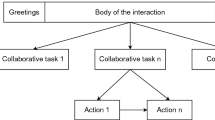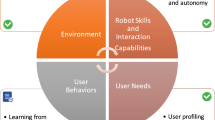Abstract
In recent years there has been an increasing interest in deploying robotic systems in public environments able to effectively interact with people. To properly work in the wild, such systems should be robust and be able to deal with complex and unpredictable events that seldom happen in controlled laboratory conditions. Moreover, having to deal with untrained users adds further complexity to the problem and makes the task of defining effective interactions especially difficult. In this work, a Cognitive System that relies on planning is extended with adaptive capabilities and embedded in a Tiago robot. The result is a system able to help a person to complete a predefined game by offering various degrees of assistance. The robot may decide to change the level of assistance depending on factors such as the state of the game or the user performance at a given time. We conducted two days of experiments during a public fair. We selected random users to interact with the robot and only for one time. We show that, despite the short-term nature of human–robot interactions, the robot can effectively adapt its way of providing help, leading to better user performances as compared to a robot not providing this degree of flexibility.











Similar content being viewed by others
References
Aaltonen I, Arvola A, Heikkilä P, Lammi H (2017) Hello pepper, may i tickle you?: children’s and adults’ responses to an entertainment robot at a shopping mall. In: Proceedings of the companion of the 12th ACM/IEEE international conference on human–robot interaction. NY, USA, pp 53–54
Alami R, Clodic A, Montreuil V, Sisbot E, Chatila R (2005) Task planning for human–robot interaction. In: Proceedings of the joint conference on smart objects and ambient intelligence: innovative context-aware services: usages and technologies, pp 81–85
Andriella A, Alenyà G, Hernández-Farigola J, Torras C (2018) Deciding the different robot roles for patient cognitive training. Int J Hum Comput Stud 117:20–29
Bennewitz M, Faber F, Joho D, Schreiber M, Behnke S (2005) Towards a humanoid museum guide robot that interacts with multiple persons. In: Proceedings of the 5th IEEE-RAS international conference on humanoid robots, pp 418–423
Bensch S, Jevtić A, Hellström T (2017) On interaction quality in human-robot interaction. In: Proceedings of the 9th international conference on agents and artificial intelligence, vol 2. pp 182–189
Breazeal C, Dautenhahn K, Kanda T (2016) Social Robotics. In: Siciliano B, Khatib O (eds) Springer handbook of robotics. Springer, Cham, pp 1935–1972
Cashmore M, Fox M, Long D, Magazzeni D, Ridder B, Carrera A, Palomeras N, Hurtos N, Carreras M (2015) ROSPlan: planning in the robot operating system. In: Proceedings of international conference on ai planning and scheduling, pp 333–341
Chan J, Nejat G (2012) Social intelligence for a robot engaging people in cognitive training activities. Int J Adv Robot Syst 9:1–13
Chen Y, Wu F, Shuai W, Chen X (2017) Robots serve humans in public places-KeJia robot as a shopping assistant. Int J Adv Robot Syst 14(3):1–20
Coles AJ, Coles A, Fox M, Long D (2010) Forward-chaining partial-order planning. In: 20th international conference on automated planning & scheduling, pp 42–49
Dayoub F, Morris T, Corke P (2015) Rubbing shoulders with mobile service robots. IEEE Access 3:333–342
Fox M, Long D (2003) PDDL2.1: An extension to PDDL for expressing temporal planning domains. J Artif Intell Res 20:61–124
Gao Y, Barendregt W, Obaid M, Castellano G (2018) When robot personalisation does not help: Insights from a robot-supported learning study. In: RO-MAN 2018 - 27th IEEE international symposium on robot and human interactive communication, vol 1. pp 705–712
Gordon G, Spaulding S, Westlund JK, Lee JJ, Plummer L, Martinez M, Das M, Breazeal C (2016) Affective personalization of a social robot tutor for children’s second language skills. In: Proceedings of the 30th conference on artificial intelligence, pp 3951–3957
Hemminghaus J, Kopp S (2017) Towards adaptive social behavior generation for assistive robots using reinforcement learning. In: Proceedings of the 12th ACM/IEEE international conference on human–robot interaction. ACM Press, New York, USA, pp 332–340
Hoffmann J (2003) The metric-FF planning system: translating “ignoring delete lists” to numeric state variables. J Artif Intell Res 20:291–341
Hong A, Igharoro O, Liu Y, Niroui F, Nejat G, Benhabib B (2019) Investigating human–robot teams for learning-based semi-autonomous control in urban search and rescue environments. J Intell Robot Syst 94(3):669–686
Kanda T, Shiomi M, Miyashita Z, Ishiguro H, Hagita N (2009) An affective guide robot in a shopping mall. In: Proceedings of the 4th ACM/IEEE international conference on Human robot interaction, pp 173–180
Lallement R, de Silva L, Alami R (2014) HATP: an HTN planner for robotics. arXiv:1405.5345
Leite I, Castellano G, Pereira A, Martinho C, Paiva A (2014) Empathic robots for long-term interaction: evaluating social presence, engagement and perceived support in children. Int J Soc Robot 6(3):329–341
Matarić MJ, Scassellati B (2016) Socially assistive robotics. Springer Handb Robot 6:1973–1994
Nardi L, Iocchi L (2014) Representation and execution of social plans through human–robot collaboration. In: Fifth international conference on social robotics, pp 266–275
Sabanovic S, Michalowski MP, Simmons R (2006) Robots in the wild: observing human–robot social interaction outside the lab. In: 9th IEEE international workshop on advanced motion control, pp 596–601
Sanelli V, Cashmore M, Magazzeni D, Iocchi L (2017) Short-term human–robot interaction through conditional planning and execution. In: Proceedings of international conference on automated planning and scheduling, pp 540–548
Tapus A, Ţapus C, Matarić MJ (2009) The use of socially assistive robots in the design of intelligent cognitive therapies for people with dementia. In: IEEE international conference on rehabilitation robotics, pp 924–929
Tomic S, Pecora F, Saffiotti A (2014) Too cool for school—adding social constraints in human aware planning. In: Proceedings of the 9th international workshop on cognitive robotics, CogRob (ECAI)
Tonkin M, Vitale J, Ojha S, Williams MA, Fuller P, Judge W, Wang X (2017) Would you like to sample’l Robot engagement in a shopping centre. In: 26th IEEE international symposium on robot and human interactive communication, pp 42–49
Tsiakas K, Abujelala M, Makedon F (2018) Task engagement as personalization feedback for socially-assistive robots and cognitive training. Technologies 6(2):49
Yuen HK, Illingworth J, Kittler J (1988) Ellipse detection using the hough transform. In: Procedings of the Alvey vision conference, vol 8. pp 1–41
Funding
This project has been partially funded by the European Union’s Horizon 2020 research and innovation programme under the Marie Sklodowska-Curie grant agreement SOCRATES (No 721619), by the Spanish Ministry of Science and Innovation HuMoUR (TIN2017-90086-R), and by the Spanish State Research Agency through the María de Maeztu Seal of Excellence to IRI (MDM-2016-0656).
Author information
Authors and Affiliations
Corresponding author
Ethics declarations
Conflict of interest
The authors declare that they have no conflict of interest.
Ethical Standard
All procedures performed in studies involving human participants were in accordance with the ethical standards of the institutional and/or national research committee and with the 1964 Helsinki declaration and its later amendments or comparable ethical standards.
Informed Consent
Informed consent was obtained from all individual participants included in the study.
Additional information
Publisher's Note
Springer Nature remains neutral with regard to jurisdictional claims in published maps and institutional affiliations.
Rights and permissions
About this article
Cite this article
Andriella, A., Torras, C. & Alenyà, G. Short-Term Human–Robot Interaction Adaptability in Real-World Environments. Int J of Soc Robotics 12, 639–657 (2020). https://doi.org/10.1007/s12369-019-00606-y
Accepted:
Published:
Issue Date:
DOI: https://doi.org/10.1007/s12369-019-00606-y




